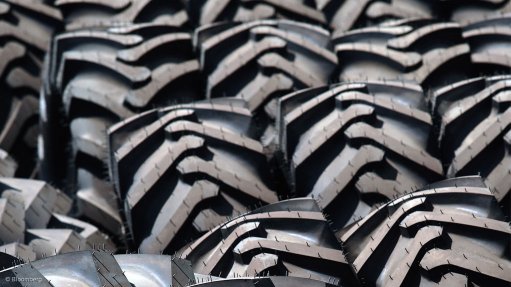
INDUSTRY ENHANCEMENT
By attaching value to a waste product, the current demand for waste tyres currently exceeds supply
Photo by: Bloomberg
The Recycling and Economic Development Initiative of South Africa (Redisa) will continue to meet the requirements of the Redisa Plan gazetted in November 2012, especially when it comes to supporting the development of small, medium-sized and microenterprises (SMMEs) to continue driving development of South Africa’s tyre recycling industry.
“This development will be achieved predominantly through investment in infrastructure, business support and research on new applications for waste,” says Redisa director Stacey Davidson.
She tells Engineering News that the South African economy produced 236 514 t of tyres in 2014, of which 177 385 t became waste tyres. Of these waste tyres, Redisa collected 56 436 t – resulting in the initiative exceeding the target set by the Department of Environmental Affairs by 2% last year.
The initiative also led to 162 SMMEs being established, and the creation of 1 617 jobs. As at December 2014, 34 tyre depots were operational nationally, with collections being made from 1 476 dealers.
“Redisa will continue to implement its five-year roll-out plan and, in 2015, our second full year of operations, we aim to deal with a maximum of 50% of all waste tyres that arise,” Davidson says, emphasising that this will lead to business growth.
Davidson believes that Redisa will play a critical role in developing an environment in which the new tyre recycling industry can continue to thrive.
“By continuing to meet our mandate of creating jobs, new industry development and a viable circular economy within the tyre industry, all while simultaneously cleaning the environment, we believe that we will have a tangible impact on South African communities and that we will assist government in meeting the targets outlined in the National Development Plan.”
In addition to reducing the environmental impact of waste tyres and tyre burning, Redisa’s initiative has addressed socioeconomic needs, which is reflected in statistics collected by the organisation, says Davidson. She highlights that the initiative has also been able to support the South African economy by investing 80% of its revenue to support the recycling industry.
“The Redisa model provides for a more transparent and responsible way for manufacturers to dispose of their products at the end of their life,” says Davidson.
She maintains that the Redisa initiative has enhanced the rubber recycling industry, as it has created a means for industry to secure feedstock, thereby enabling a viable recycling industry. This allows for manufacturers to focus on their core business and become more competitive and viable, while Redisa takes on the business of environment management.
“Before Redisa existed, the tyre industry was unable to deal with its waste in a responsible way. However, by implementing a ‘waste into worth’ approach – or a circular economy concept – into the industry, and pioneering the Redisa model, the tyre industry also encourages resource efficiency.”
In light of this, Davidson highlights driving awareness about the value of these economies and the opportunities they create as Redisa’s key strategy for this year.
Waste-Into-Worth Demand
While there was no real demand for waste tyres before the Redisa plan was established by attaching value to a waste product, the current demand for waste tyres currently exceeds supply, notes Davidson.
“We have noted that the demand for rubber has increased and that people are more open to becoming involved in the recycling industry.”
Davidson says this increased demand extends to secondary products, such as road builders using rubber crumb fillers in asphalt; makers of solid tyres; and makers of planters, chairs and blasting mats, with international interest from secondary industries considering investment in South Africa.
She adds that building a rubber-crumbing industry in South Africa is also a possibility, as “a waste tyre has a high intrinsic value” and the rubber extracted through crumbing could be used in a wide range of products across the household and recreation sectors, as well as in industry.
Crumb rubber is the result of processing automotive and truck scrap tyres. During this process, the steel and tyre cord, or fluff, is removed, leaving tyre rubber with a granular consistency. This rubber crumb is often used in astroturf as cushioning, where it is sometimes referred to as astrodirt; and in floor mats, carpet padding, vehicle mudguards, adhesives and asphalt for tarring roads.
“Through research and development – specifically on new applications for waste tyres – Redisa will continue to look at new ways to use waste tyres and extract chemicals and compounds from them,” concludes Davidson.